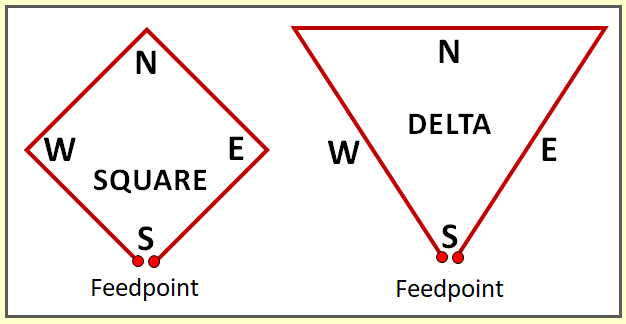SKY-LOOP RADIATION PATTERNS:
SQUARE-LOOP Vs. DELTA-LOOP
THIS page compares the radiation patterns of the Square-Loop with Delta-Loop. There are two graphs for each band. The graph on the left shows their horizontal radiation patterns, the graph on the right shows their vertical radiation patterns.
In all cases, the antennas were oriented as shown below:

On the horizontal graphs, North is at the top (center) of the antenna (i.e., at 12 o'clock), and the feedpoint is located at the South corner.
80m Radiation Patterns:
HORIZONTAL VERTICAL

80m Comments: The two antennas are basically identical. (Flip a Coin)
They are omni-directional with maximum gain straight up. Thus the nickname "Cloud Burner". But don't let this confuse you. You can still work plenty of DX on 80m with these antennas; albeit, at 20 degrees the radiated signal is about 2 S-Units weaker than at 90 degrees.
40m Radiation Patterns:
HORIZONTAL VERTICAL

40m Comments: Still very little difference. Basically omni-directional with a high angle of radiation; maximum gain is at about 50 degrees. Never-the-less, these antennas still perform excellent for DX on 40m. At a radiation angle, the signal strength is only about 1 S-Unit down on its maximum gain.
An 80m SKY-LOOP is a perfect antenna for a Net Control Station in a 40m Net. It radiates a strong signal in all directions. Assuming there are stations in all directions, this is a much better antenna than a dipole.
When working DX, unless you are only interested in one direction, this is also a much better antenna than a dipole antenna which has very deep nulls off its ends.
20m Radiation Patterns:
HORIZONTAL VERTICAL

20m Comments: On 20m (and higher bands) we see a difference in the horizontal radiation pattern, but not so much in the vertical radiation pattern. Which configuration is better will depend on the QTH and which directions interest the operator the most.
For instance, here in Europe we have a good argument for choosing the square loop and running it with the wires erected north to south, south to east, east to north, & north to west. This gives us strong lobes in 4 DX directions:
- Northwest: towards Stateside
- Southwest: Long Path towards VK/ZL
- Southeast: towards the Middle-East
- Northeast: towards JA/BY
Others might be interested in a more omni-directional pattern. In this case, the Delta-Loop would be the favorable antenna. It is still 'kinda' omni-directional, whereas the Square-Loop is not; it has 4 strong lobes with very deep nulls in between the lobes.
15m Radiation Patterns:
HORIZONTAL VERTICAL

15m Comments: On this band both patterns become more complex, having more lobes. Whereas the Delta-Loop now has 6 horizontal lobes, the Quad-Loop has 8 lobes. In addition to the low-angle omni-directional vertical lobe, there are now two high-angle vertical lobes, albeit quit a lot weaker than the primary lobe. Notice that the primary vertical lobe is at an even lower angle on this band than on 20m.
These cannot really be considered "omni-directional", as the nulls between lobes can be quite deep. Whether one of the lobes happens to be pointing at an intended DX direction or not will depending on your QTH and the QTH of the DX station.
10m Radiation Patterns:
HORIZONTAL VERTICAL

10m Comments: Wow! This is even more complex. Whereas the Square Loop now has 12 horizontal lobes, the Delta Loop has 16, albeit the 4 additional lobes are quite weak. The Square Loop has 4 vertical lobes and the Delta Loop has 6, with 2 of its lobes being relatively high.
These cannot really be considered "omni-directional", as the nulls between lobes can be quite deep. Whether one of the lobes happens to be pointing at an intended DX direction or not will depending on your QTH and the QTH of the DX station.
Summary and Comments:
These full-wave 80m SKY-LOOPs have a high angle of radiation on their fundamental band. Each higher harmonic band has a lower radiation angle than its predecessor, due to the antenna being electrically higher with rising frequency.
As stated above, though they have a reputation for being a
"Cloud Burner" on their fundamental band, do not mistake that for meaning they are not good for DX. A dipole at the same height might be slightly stronger off its sides, but this so-called "cloud burner" will out-perform the dipole off it ends, even when working DX!
Although these antennas have multiple strong lobes with significant gain on the higher bands, they also have deep nulls in between the lobes. When one of the lobes is pointed at the DX station you wish to work, this antenna will easily compete with a 3 element beam (at the same height). But is the DX station is in the direction of one of the nulls, a simple vertical will out-perform the loop.
